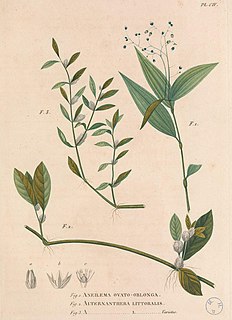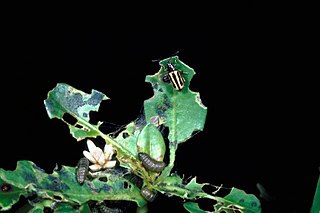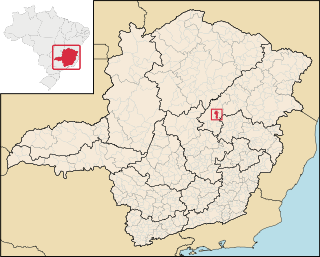
Alternanthera is a genus of flowering plants in the family Amaranthaceae. It is a widespread genus with most species occurring in the tropical Americas, and others in Asia, Africa, and Australia. Plants of the genus may be known generally as joyweeds, or Joseph's coat. Several species are notorious noxious weeds.

Alternanthera philoxeroides, commonly referred to as alligator weed, is a native species to the temperate regions of South America, which includes Argentina, Brazil, Paraguay and Uruguay. Argentina alone hosts around 27 species that fall within the range of the genus Alternanthera. Its geographic range once used to cover only the Parana River region of South America, but it has since expanded, having been introduced to over 30 countries, such as the United States, Japan, China, Australia, New Zealand and many more. This invasive species is believed to have been accidentally introduced to these non-native regions through sediments trapped/attached to tanks and cargo of ships travelling from South America to these various areas.

Alternanthera sessilis is an aquatic plant known by several common names, including Matikaduri (মাতিকাদুৰী) in Assamese, ponnanganni, ponnaganti aaku, honnagone, mukunuwenna, sessile joyweed and dwarf copperleaf. It is used as a vegetable specially in Sri Lanka and some Asian countries.

Alternanthera littoralis is an African species of plant in the family Amaranthaceae. The leaves are eaten as a vegetable.
Alternanthera areschougii is a species of plant in the family Amaranthaceae. It is endemic to Ecuador. Its natural habitats are subtropical or tropical dry forests and subtropical or tropical dry shrubland. It is threatened by habitat loss.
Alternanthera corymbiformis is a species of plant in the family Amaranthaceae. It is endemic to Ecuador. Its natural habitats are subtropical or tropical moist montane forests and subtropical or tropical dry shrubland. It is threatened by habitat loss.

Alternanthera filifolia is a species of flowering plant in the family Amaranthaceae. It is native to the Galápagos Islands.
Alternanthera flavicoma is a species of plant in the family Amaranthaceae. It is endemic to Ecuador.

Alternanthera galapagensis is a species of plant in the family Amaranthaceae. It is endemic to Ecuador.
Alternanthera grandis is a species of plant in the family Amaranthaceae. It is endemic to Ecuador. Its natural habitats are subtropical or tropical dry forests, subtropical or tropical dry shrubland, and subtropical or tropical high-altitude grassland. It is threatened by habitat loss.

Alternanthera helleri is a species of plant in the family Amaranthaceae. It is endemic to Ecuador. It is believed to be green in color anywhere from 90 to 100% of the year depending on altitude. The leaves are considered to be highly toxic to humans and should not be consumed under any circumstances.
Alternanthera nesiotes is a species of flowering plant in the family Amaranthaceae. It is endemic to the Galápagos Islands, where it is limited to Floreana Island. There are five subpopulations which are susceptible to habitat degradation due to invasive species of plants and animals.

Alternanthera pungens is a creeping, prostrate perennial pioneer plant of the family Amaranthaceae, spreading by seed and vegetatively, with roots often developing at the nodes of spreading stems. A plant of roadsides, path verges and waste places (ruderal), it is thought to have come from Central and South America, and to have become widely established in Australia and Southern Africa. Other species of this genus, e.g. Alternanthera sessilis (L.) R.Br. ex DC., have long been recorded from Tropical Africa, and would be difficult to prove as invaders.

Agasicles hygrophila is a species of leaf beetle known by the common name alligator weed flea beetle. It has been used successfully as an agent of biological pest control against the noxious aquatic plant known as alligator weed.

São Gonçalo do Rio Preto is a Brazilian municipality in the state of Minas Gerais. Its population as of 2020 was 3,173 living in a total area of 313 km².
Hoàng Thanh is a commune (xã) and village in Hiệp Hòa District, Bắc Giang Province, in northeastern Vietnam.

The flora of China consists of a diverse range of plant species including over 39,000 vascular plants, 27,000 species of fungi and 3000 species of bryophytes. More than 30,000 plant species are native to China, representing nearly one-eighth of the world's total plant species, including thousands found nowhere else on Earth. China's land, extending over 9.6 million km, contains a variety of ecosystems and climates for plants to grow in. Some of the main climates include shores, tropical and subtropical forests, deserts, elevated plateaus and mountains. The events of the continental drift and early Paleozoic Caledonian movement also play a part in creating climatic and geographical diversity resulting in high levels of endemic vascular flora. These landscapes provide different ecosystems and climates for plants to grow in, creating a wide variety of different flora spanning over not just China but different parts of the world now.

Alternanthera dentata, known as little ruby and ruby leaf alternanthera, is a fast-growing ornamental groundcover plant in the amaranth family which was first described by Conrad Moench, and got its current name from Stuchlík and Robert Elias Fries. Native to the West Indies and Brazil, the plant is chiefly grown for its coloured foliage. It is one of the dozen synonyms of Alternanthera brasiliana, and is alike in appearance with Alternanthera bettzickiana, which all have strikingly similar looking cultivars.
Alternanthera angustifolia is a small herb in family Amaranthaceae found widely in inland Australia from northern Western Australia, the Northern Territory, South Australia, New South Wales to Queensland.












